Lord Byron, dead
Guest post by author and journalist Ann Treneman.
Over the past four years, I have spent almost all my spare time in cemeteries for my new book ‘Finding the Plot: 100 Graves to Visit Before You Die‘. One of the key things that I have discovered is that having the right funeral is all about planning. There’s no point in dying and just hoping for the best. You’ve got to treat your funeral as if it were a major event in your life (which, of course, it is, except for the tiny detail that you are dead).
So, here, then, are three cautionary tales: three brilliant men who got their deaths quite wrong.
The first is Charles John Huffam Dickens, as his full name was. The man who wrote so much about cemeteries (not to mention grave-robbing) and funerals did his best to 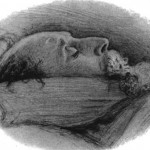 micromanage his own: “I emphatically direct that I be buried in an inexpensive, unostentatious and strictly private manner; that no public announcement be made of the time or place of my burial; that at the utmost not more than three plain mourning coaches be employed; and that those who attend my funeral wear no scarf, cloak, black bow, long hat-band or other such revolting absurdity.” So what was the only thing he forgot to stipulate? Yes, that’s right: location.
micromanage his own: “I emphatically direct that I be buried in an inexpensive, unostentatious and strictly private manner; that no public announcement be made of the time or place of my burial; that at the utmost not more than three plain mourning coaches be employed; and that those who attend my funeral wear no scarf, cloak, black bow, long hat-band or other such revolting absurdity.” So what was the only thing he forgot to stipulate? Yes, that’s right: location.
Dickens died in 1870 at his home Gad’s Hill, near Rochester, Kent. Apparently that is where he wanted to buried but The Times newspaper had other ideas 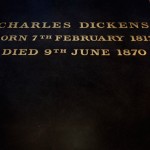 (just a tiny unostentatious plot in Westminster Abbey) and as this was the one detail that the hyperactive novelist had failed to mention, The Times prevailed. Thus, in the middle of the night, a grave in Poet’s Corner was dug. The body arrived at 9.30am by anonymous hearse. Only 12 people attended although history does not record if any dared to wear an “absurd” hat-band. But, even as the quiet event finished, journalists were banging at the abbey doors. In the end, the grave was left open for two days as thousands came to pay their respects, throwing in flowers. So not quite the strictly private event that Dickens decreed. In fact, not at all.
(just a tiny unostentatious plot in Westminster Abbey) and as this was the one detail that the hyperactive novelist had failed to mention, The Times prevailed. Thus, in the middle of the night, a grave in Poet’s Corner was dug. The body arrived at 9.30am by anonymous hearse. Only 12 people attended although history does not record if any dared to wear an “absurd” hat-band. But, even as the quiet event finished, journalists were banging at the abbey doors. In the end, the grave was left open for two days as thousands came to pay their respects, throwing in flowers. So not quite the strictly private event that Dickens decreed. In fact, not at all.
If only Thomas Hardy had studied his Dickens a bit better he might have been more explicit about what was to become of him. The great novelist had told his literary executor that he would like to be buried at St Michael’s Church in Stinsford in Dorset (the mythical Mellstock of his writings). “I do not, in truth, feel much interest in popular opinion of me,” he said, “and 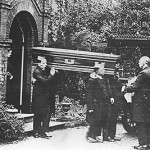 shall sleep quite calmly in Stinsford, whatever happens.”
shall sleep quite calmly in Stinsford, whatever happens.”
But when Hardy (left) died in 1928, at the age of 87, he was overruled and he was no longer there to argue otherwise. His executor Sydney Cockerell and J.M. Barrie of Peter Pan fame decided that he must, instead, be buried in Westminster Abbey, as close to Dickens as possible. (How ironic is that?) His family were outraged. Finally, the vicar at Stinsford came up with a classic English fudge: his heart would be buried in Stinsford, the rest of him, after cremation, would go to the Abbey.
Thus, on 16 January 1928, there were two funerals. The great and the good gathered in the Abbey while, at Stinsford, there was a much simpler service, after which the small 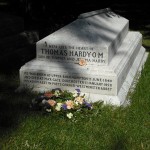 heart-sized box was buried in his first wife’s grave (left). Of course, in the pubs, this was the spark for many a joke, including those about resurrection (where was the rest of him?) and speculation that, actually, a cat had eaten his heart while on the slab. But, I have to say, having visited both the Abbey and Stinsford, that I have no doubt where he belongs – and it’s not London.
heart-sized box was buried in his first wife’s grave (left). Of course, in the pubs, this was the spark for many a joke, including those about resurrection (where was the rest of him?) and speculation that, actually, a cat had eaten his heart while on the slab. But, I have to say, having visited both the Abbey and Stinsford, that I have no doubt where he belongs – and it’s not London.
Finally, then, we come to Byron whose will had stipulated that he was to be buried with his beloved Newfoundland dog Boatswain (left, click to enlarge) in his glorious plot that still lies in the ruins of 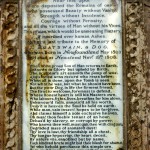 Newstead Abbey in Nottinghamshire. But Boatswain died in 1808 and his master lasted (just) until 1824. Byron, of course, was the king of scandal, with rumours and accusations of infidelity, sodomy, violence and incest all playing a part.
Newstead Abbey in Nottinghamshire. But Boatswain died in 1808 and his master lasted (just) until 1824. Byron, of course, was the king of scandal, with rumours and accusations of infidelity, sodomy, violence and incest all playing a part.
No one was surprised when he fled to Greece, where he died while fighting for independence. His body lay in state in Athens for three days before returning to England by boat. But back home, it turned out Westminster Abbey did not want him. And the new owners of Newstead Abbey (he had sold it to pay some debts) weren’t going to have him interred with Boatswain either. So it was nearby Hucknall for him.
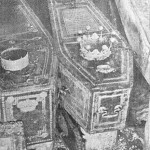 The funeral cortege that left London was really most peculiar. The first hearse contained a coffin, the next vases with his internal organs. Many of the other coaches were empty, their owners having hit on the marvellous wheeze of “ghost” appearances as a way of paying tribute to the poet without, actually, being seen to condone his behaviour. In Hucknall, though, people queued for four days to see the coffin (left, left). Creepily, in 1938, the coffin was re-opened with the vicar reporting that Byron was, indeed, there, including descriptions of his deformed foot and his genitals. Truly, for Byron, there was no peace in death, though we should not be surprised.
The funeral cortege that left London was really most peculiar. The first hearse contained a coffin, the next vases with his internal organs. Many of the other coaches were empty, their owners having hit on the marvellous wheeze of “ghost” appearances as a way of paying tribute to the poet without, actually, being seen to condone his behaviour. In Hucknall, though, people queued for four days to see the coffin (left, left). Creepily, in 1938, the coffin was re-opened with the vicar reporting that Byron was, indeed, there, including descriptions of his deformed foot and his genitals. Truly, for Byron, there was no peace in death, though we should not be surprised.
Ann Treneman’s book, Finding the Plot: 100 Graves to Visit Before You Die, is published by the Robson Press at £12.99. You can purchase it online through Amazon or the publisher (https://www.therobsonpress.
ED’S NOTE: We read a review of Ann’s book and asked her to write for us. We are very grateful to her for agreeing to do so.


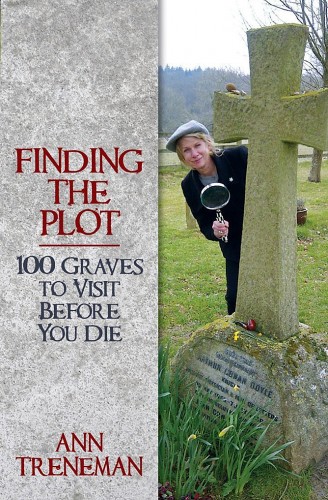

Fascinating Ann – thank you. A warning to us all. In the words of the Rolling Stones, ‘You can’t always get what you want…’
On a lighter note, Mr Perry is at a loss as to what to buy me for Christmas. Does your book include directions to the nearest hostelry for each location?
We need a phrase to cover these mischances – like many a slip between cup and lip. Maybe ‘grave or lair, you’re not safe till you’re there…’
O well first thoughts only.
Fascinating stories. You can’t help but love the spirit of admiration that allows you to disregard the wishes of the admired. If the book has more, it’ll be a great read.
[…] was nice to have Ann Treneman write for us last week about the vital importance of specifying where you want your dust or ash to […]